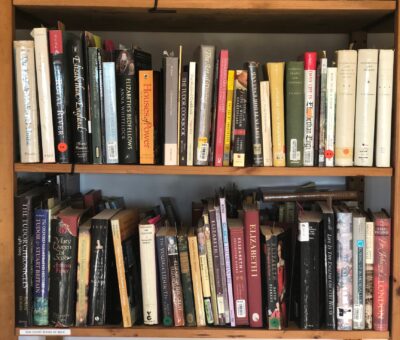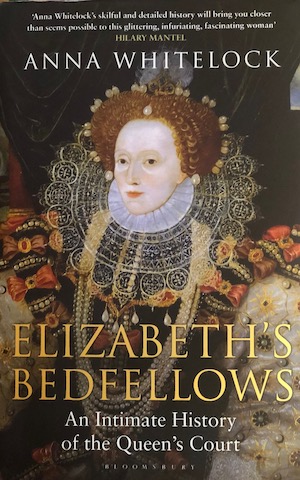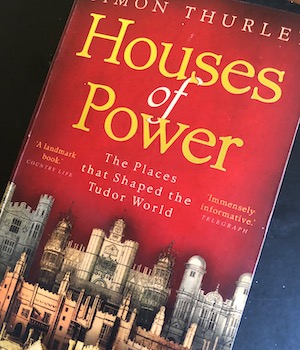I recently read an article by the elusive Ryan Holiday, a professional book researcher. He made one very important point—at least to me. He said that the first step in researching is to acquire a research library which will include books that you will likely never read. He calls it an anti-library.
We all have books and papers that we haven’t read yet. Instead of feeling guilty, you should see them as an opportunity: know they’re available to you if you ever need them.
This is exactly what I do: buy too many books, print out too many articles, and read only a fraction of them. So now I’m going to stop feeling guilty about it.

Two of six shelves for the WIP. Note the white tag in the lower left. It reads: “Sun Court books at the back.” In other words, I’ve run out of shelf space.
One of my rules as a reader is to read one book mentioned in or cited in every book that I read.
I often scour footnotes for references to books the author has relied on. Lately, I’ve acquired two books in this way and they have proved to be invaluable.

One is Elizabeth’s Bedfellows; An Intimate History of the Queen’s Court by British historian Anna Whitelock. She was one of the experts on a documentary on Elizabeth I. I ordered her book and immediately on opening it saw details I badly needed to write a scene that had me stumped. I will only need a few chapters of this book—at least for this WIP—but they are gold to me.

The other book is a paperback edition of Houses of Power; The Places the Shaped the Tudor World by Simon Thurley. (Note that this book can be hard to find, at least in North America. I finally found a used copy on Abebook.com.)
I have a number of works by this wonderful historian, but this is the book that made me gasp. It’s full of the floorplans of Tudor palaces at that time, and amazing details as well. In no time flat, I began to mark it up.


A research trick I use: for a print book I own, if the “search me” feature is available on Amazon, I will add it to a list. Say I’m looking for events in 1553: I’ll search for that year in the Amazon link of the book—note that it has to be the print edition—and this will give me the pages to go to in my copy of the book. It’s an instant index to the type of thing that would never show up in an official index.
Since posting this, I’ve had the pleasure of listening to a podcast interview of Professor Simon Thurley on The Tudor Travel Show. Fascinating! He also has two free online lectures I’m looking forward to listening to: Tudor Ambition; Houses of the Boleyn Family and Ruling Passions: The Architecture of the Cecils. As well, he has launched an invaluable research website that provides up-to-date information on royal palaces: RoyalPalaces.com.
Dr. Sarah Morris of The Tudor Travel Show (above) is an invaluable source of information, both through her Tudor Travel videos and podcasts, but also through her writing: her two novels about Anne Boleyn—Le Temps Viendra (I and II)—as well as the abundantly detailed non-fiction account In the Footsteps of Anne Boleyn, written together with On the Tudor Trail podcaster Natalie Grueninger.
The art at the top is from Bibliodessy.



Wow, thank you for this insight. I’m taking on my first historical project and I’ve been feeling overwhelmed. This is so helpful!
I’m so glad, Cristi! Thank you so much for letting me know. I’m always trying to figure out how best to keep track. I’ve recently begun to use Evernote as the dumping ground for all my research (filed and tagged appropriately there), and then migrate the research selectively into Scrivener as needed. Before I was putting everything in Scrivener, which was not a great idea because I had so much. (Maybe I should write a blog post on this process.) I’m also finding Aeon Timeline invaluable, if only for keeping track of how old everyone is in a scene.
Great post!!! Thanks, Elizabeth
Thank you, Elizabeth!